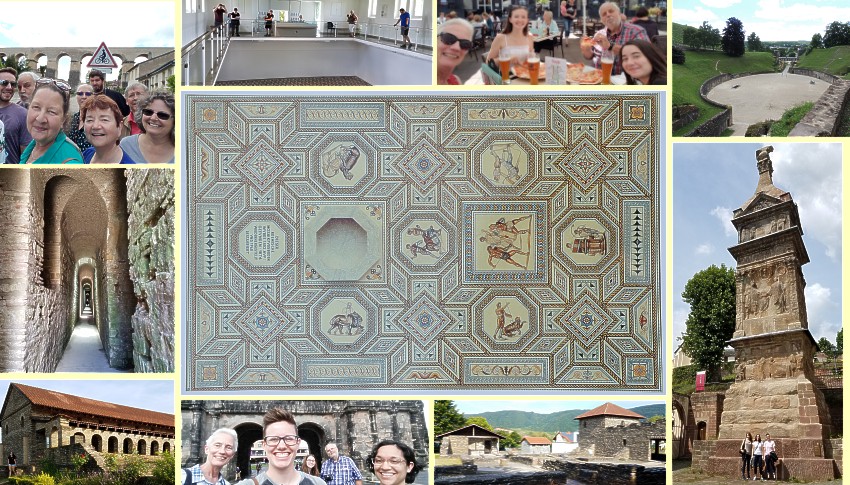Kansas Snapshots by Gloria Freeland - August 9, 2019
Roman roamin'
The Roman empire, at its peak during the 2nd century A.D., stretched from Spain in the west to Iran in the east, Egypt in the south
to Scotland in the north. Husband Art and I have never been to most of this area, but we have enjoyed visiting Roman sites in Great
Britain and Europe.
Every year since 2014, we’ve stayed in the French city known as Divodurum in the 4th century, but after the 6th century was called
Metz. During Roman rule, the population’s thirst was quenched by fresh water transported by an aqueduct from mountain springs to the
southwest. Citizens were entertained in an amphitheater, bathed in thermal baths, and were protected by a city wall.
Today, the city’s Cour d’Or (Gold Court) museum has pieces from the baths, as well as the chancel of Saint-Pierre-aux-Nonnains church.
The shell of the church still stands and was originally a Roman gymnasium - a secondary school - complete with a rectangular court
surrounded by colonnades.
Metz is located in what was called Gaul, the area inhabited by Celtic tribes before the Romans arrived. It encompassed present-day
France, Luxembourg, Belgium, most of Switzerland and parts of northern Italy, the Netherlands and Germany.
This past summer, we explored a number of Roman sites within a 50-mile radius of Metz. The first was the stone bridge that supported
the aqueduct at the river crossing near Jouy-aux-Arches just south of Metz. It has been restored several times since 1837 and passes
over the roadway 75 feet below. While those living close by seem unimpressed with the structure, I find it amazing each time we
return.
Art “discovered” the Roman villa in Nennig, Germany after we had zipped by it on several trips to Trier. While there isn’t much left
of the villa itself, the 34-by-52-foot mosaic floor - made up of three million individual tiles with a marble fountain - is
captivating. It is one of the few mosaic floors that can be viewed at its original site and is considered one of the two most
important ones north of the Alps. A local farmer discovered it in 1852, and a shelter was built to protect it in 1874. Archaeologists
date the mosaic to the 3rd century. The central square is a depiction of a gladiator, and six octagonal scenes surrounding the square
show musicians and hunting scenes.
Not far from Nennig is a 98-foot-tall Roman sandstone column, dating to about 250. The column, a UNESCO World Heritage Site, includes
bas-relief sculptures of six tenant farmers bringing a hare, two fish, a kid, an eel, a rooster and a basket of fruit to
the house of their master.
In the 4th century, Trier, which is Germany's oldest city, was one of the largest cities in the Roman Empire, with a population
between 75,000 and 100,000. Among its Roman remains are an almost-complete amphitheater, including underground passageways where
gladiators and animals were kept until they entered the arena. Other impressive sites in Trier are the Imperial Baths and the walled
city’s eastern entrance gate - the Porta Nigra or “Black Gate,” so named because of its color.
While most of the artifacts in the city are just for viewing, the foundation of one of Trier’s busy bridges over the Mosel River -
the German name for the Moselle River - was made by the Romans.
We also stopped near Trier at the remains of two Roman villas - one in Mehring and one outside Longuich. The former was in the middle
of the village and had labels on the walls to indicate where the bath, latrine and other rooms had been. The latter villa was in the
middle of a farmer’s vineyard near the river - a beautiful setting, with grape vines, flowers, green hills and the quaint village
spread out in front of it. It too had a mosaic tile floor, although much smaller than the one at Nennig.
Much of our Trier trip was along the “Roman road,” which hugs the winding Mosel River. Its banks are covered with grape vines and are
often so steep that it can be entertaining just watching the farmers at work. These vineyards are also a legacy of the Romans. Today’s
major wine-making regions in France, Germany, Italy, Portugal and Spain can be traced back to the Roman belief that wine was a daily
necessity. The Romans made the drink available to slaves, peasants and women as well as male aristocrats. To ensure a steady supply
for Roman soldiers and colonists, wine production spread to every part of the empire. The economic opportunities presented by wine
trading drew merchants to do business with tribes native to Gaul even before the arrival of the Roman military.
Romans also liked pasta, olive oil, sauces and bread. Today, for every restaurant in Metz serving authentic French cuisine, there are
many times that number serving pizza and pasta. A similar situation exists in Trier and other cities in the area. We have stopped
repeatedly at Vianotta, an Italian restaurant in Trier. This summer, Art and our young friends Courtney and Emma consumed pizzas
larger than their plates! It was also a favorite with our own girls and other friends during past visits.
While ice cream is a Chinese invention, the Italian version - gelato - seemed like a perfect way to end this summer’s tour of Roman
sites. So Art pulled over at the Eiscafe (ice cream café) Pinocchio in Trittenheim on the banks of the Mosel.
As the sun dropped toward the horizon on the warm summer evening, we sat in the car enjoying the different flavors - lemon, raspberry,
pomegranate, strawberry, vanilla and hazelnut. What a perfect way to end our Roman roamin’!
